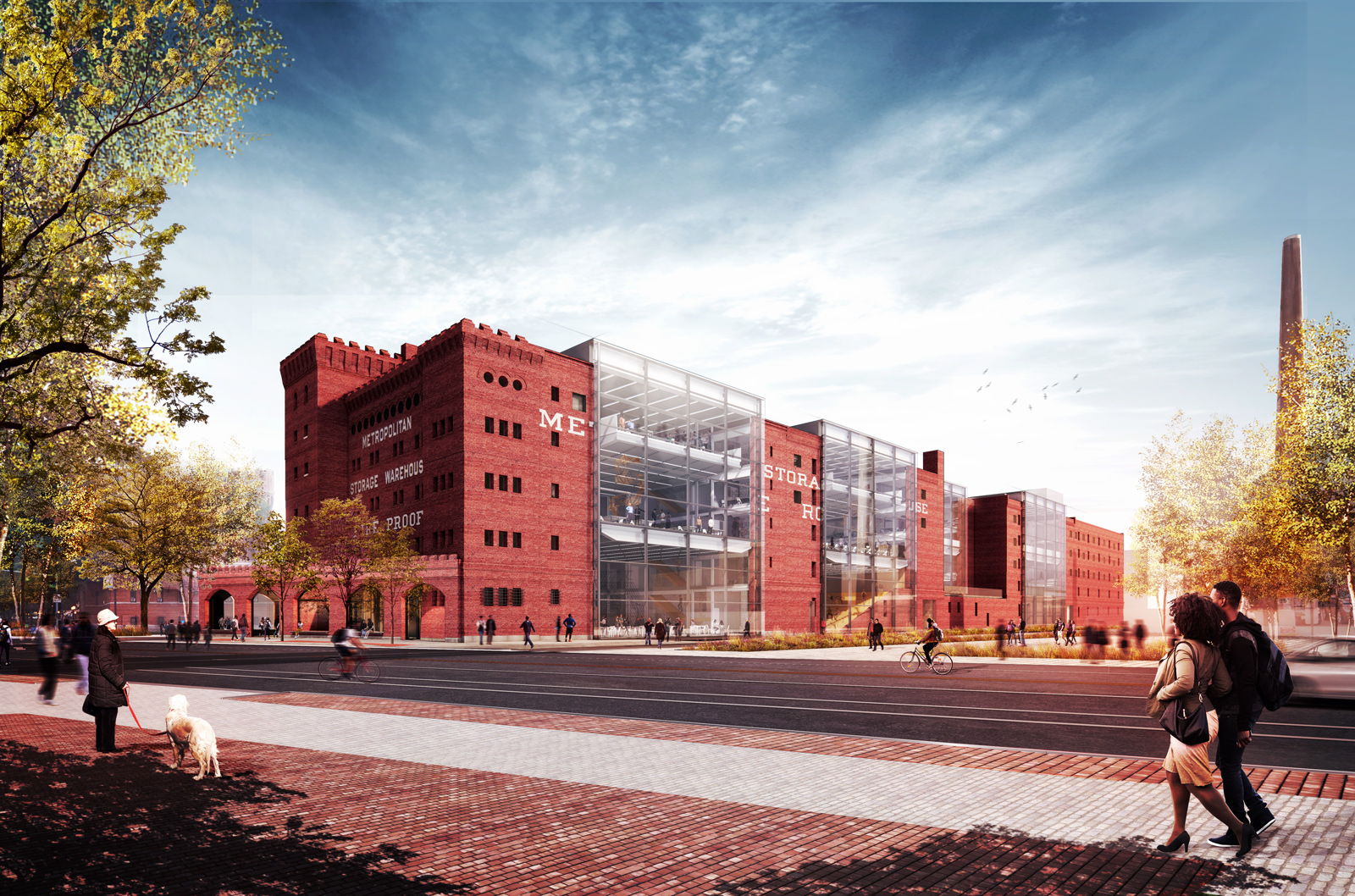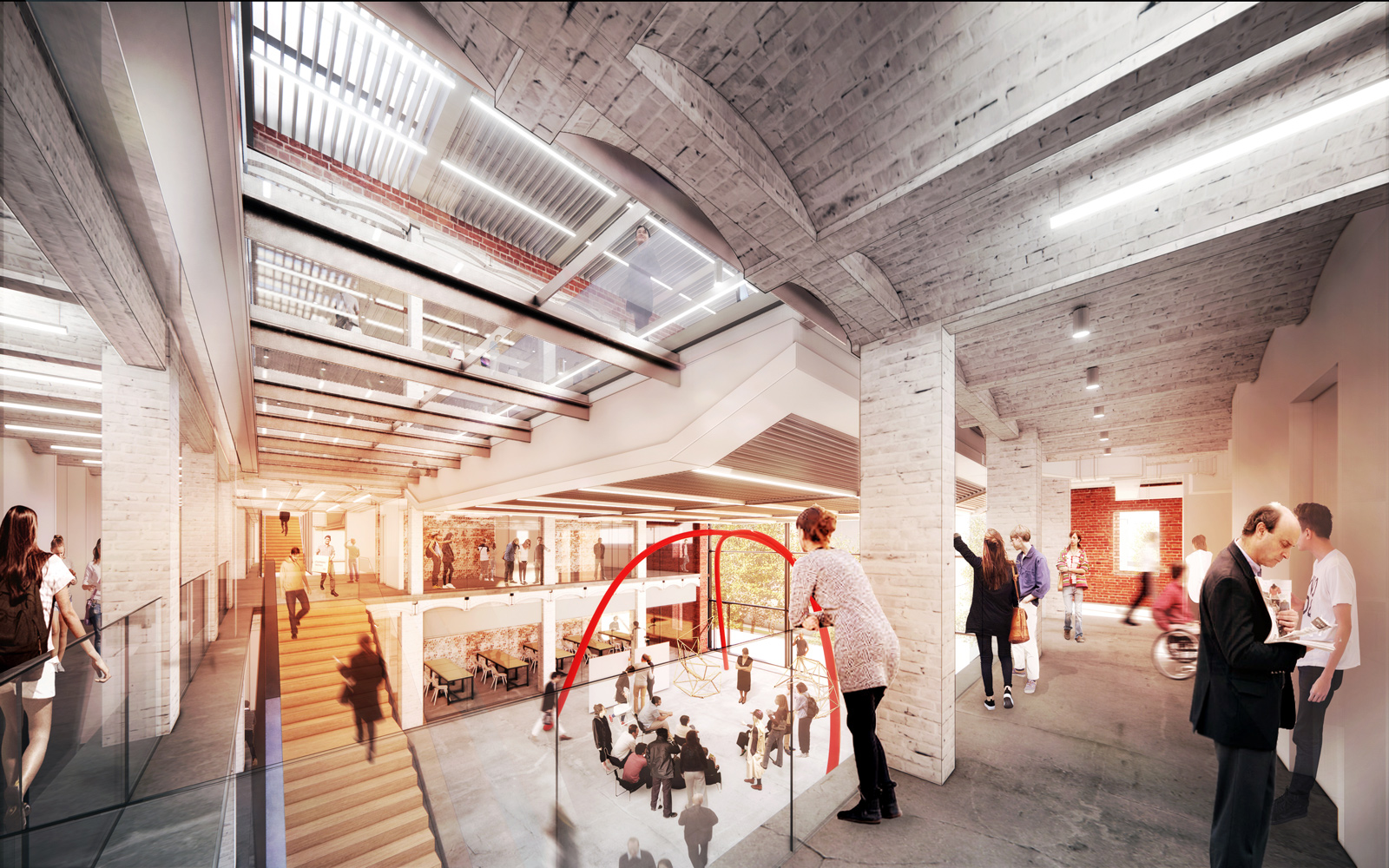
John Ochsendorf and Maria Yang, leaders of the Morningside Academy for Design, outside the under-construction Metropolitan Warehouse building, which will be home to the new Academy and serve as a design hub for all of MIT.
PHOTO: TONY LUONG
The Institute is home to the nation’s first department of architecture, established in 1865, which began offering a widely popular design minor in 2016. Now, the new MIT Morningside Academy for Design is harnessing these resources to take design to a new level, both on campus and beyond.
Launched in March 2022 as a major interdisciplinary center, the Academy builds on the Institute’s leadership in design-focused education and aims to be a global hub for design research, thinking, and entrepreneurship. MIT professors John Ochsendorf, Morningside Academy founding director, the Class of 1942 Professor, and professor of architecture and civil and environmental engineering, and Maria Yang ’91, Morningside Academy associate director, the Gail E. Kendall Professor of Mechanical Engineering, and associate dean of the School of Engineering, discuss how the Academy will elevate design at MIT and in the greater world, supporting students and faculty who are champions of innovation.
What does “design” mean, and why is it so important, especially here at MIT?
Ochsendorf: Design is many things to many people. In some cultures, when people say “design” they refer to aesthetics, the external appearance of a product or structure. But the definition is much broader than that—design is how we deploy technology to serve people. That’s particularly important to emphasize at MIT, where we’re creating and embracing new and existing technologies every day.
Yang: We talk about making a “better world” at MIT, and design is a great way to approach that. Design is the primary mover that gets you from a basic technology to something that is usable by a human being. For example, we have all sorts of technologies that exist for clean cooking, but how do you translate that research into a clean-burning cookstove that will be embraced by families in low-income countries? Or consider a new vaccine. It might look great in the lab, but someone must figure out the system to get it in a syringe, refrigerate and deliver it, educate people, and make it available—the whole process. These examples take basic technology and use design to connect it to users, and that translation can be very hard.
Ochsendorf: With a design-oriented perspective, the framing of the problem becomes as important as the solution. In an educational setting, when students and researchers are challenged with an open-ended design project, they must frame what is important, develop novel solutions, prototype them, and think about how they can scale them to work in the world. That is such a valuable experience and an amazing way of applying the brilliant technical ideas that our students are learning.
What are the goals of the Morningside Academy, and how will this new entity alter the design landscape at MIT?
Ochsendorf: The Academy supports students and faculty who are conceiving and working on novel design solutions across disciplines. Design-based projects are a perfect way to cut across disciplines, because you’re in search of a common solution. We’re creating design leaders of the future who represent the broadest spectrum of humanity, both in their own experience and in the projects they pursue. Our priorities include developing curricula to support new design-related classes, funding undergraduate research projects that have a strong design component, creating high-profile graduate fellowships, and exposing students to research and educational opportunities in design at and beyond MIT. On a broader scale, we want to make sure that when people think of creativity and design, they think of MIT as the leading university in the world. STEM—science, technology, engineering, and math—should be synonymous with creativity, invention, and design, but right now it’s not for many people, neither in the public nor in our professions.
Read More
Q&A: Fueling Design at MIT
Yang: Building a larger design community within MIT is particularly important. We want to make sure everyone knows that people do design here and to bring those people together. When I was a mechanical engineering major here, I would have loved to be a part of a larger design community, but it really wasn’t something I was aware of on campus, and I’ve heard similar sentiments from other alumni. With the Morningside Academy, we’re excited to raise the visibility of design on campus and share that with the outside world. We’re creating new initiatives but also leveraging existing MIT programs and assets.
Why is interdisciplinary collaboration a key focus of the Academy?
Ochsendorf: New insights emerge when you bring together expertise from different disciplines, and MIT has always embraced this idea to some degree. We envision the Academy bringing undergraduate engineering majors together with Sloan MBA students to craft new products, for example, or pairing Department of Urban Studies and Planning fellows with biochemists to work on challenges relating to public health. This will happen through courses and public programming but also through common spaces and social activities. One of our core ideas is to create cross-fertilization by offering graduate fellowships for anyone who’s working in design in any discipline and by bringing that cohort of new fellows together so they can look for methodologies and approaches from other fields that apply to their own work. It’s important to support risk-taking designers who are thinking outside the box, even if their ideas are radical for their discipline.
In general, do students arrive at MIT with design on their radar as something they want to pursue?
Ochsendorf: One of the great joys of teaching at MIT is that our students are inherently designers—creative tinkerers who are already making and thinking. Many of them, no matter their field, arrive with a design portfolio. That trajectory should extend even further once they’re here so that they’re as comfortable tackling open-ended, ill-defined problems as they are in solving well-defined, closed-form equations.
Yang: That said, we have a lot of students who come in with strong technical skills but not much design experience. When they take a design class here, we often see a little switch go off as they realize they have the freedom to be creative in a different way. We want to support that passion and make them understand that it’s something they can bring to their work at MIT and to their future careers.
How can physical spaces, like the Metropolitan Warehouse currently under renovation, support that interdisciplinary mindset?
Yang: Space for people to come together and incubate ideas, generate new thoughts, and build a sense of community is so important at MIT. The Academy is a driver for those facets of community-building, and the Met Warehouse will eventually be a fantastic physical manifestation of that for design, both by hosting programming and by acting as a social space.
Ochsendorf: MIT’s innovative spirit and ability to work across disciplines is also inherent in our campus architecture overall, with interconnected buildings that for the most part don’t have boundaries between departments. This fluidity is a hallmark of our culture, and the opportunity and the challenge for the Met Warehouse as a hub for design is to be a continuation of that ecosystem.
Design can be an important factor in promoting equity across populations. How will the Academy make progress in this area?
Yang: “Design justice” is a movement that rethinks design processes to open up design to participation by a broader cross-section of the community to address inequality. In the Academy’s efforts to champion design across disciplines, we have the opportunity to help our instructors and students take these principles into consideration when they design products and systems. There can be a big gap between having an awesome technology that works in the lab and something that is actually useful and equitable for end users from various populations. To make truly socially impactful change, we must design things in a way that deeply considers the human side of the equation.
Ochsendorf: When designing, it’s critical to understand the cultural context and to consider why end users would desire any particular technology. Many of the challenges that the planet faces, from climate change to public health to inequality, can be tackled if we use a design lens to consider solutions. We need solutions that are not purely technical and not purely policy-based. The goal of a designer is to imagine the world that we want to see.

